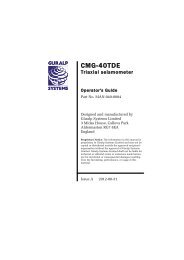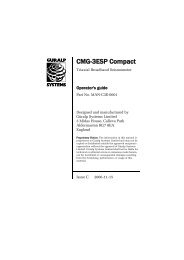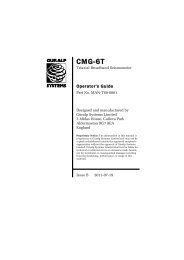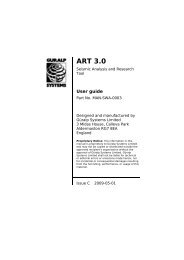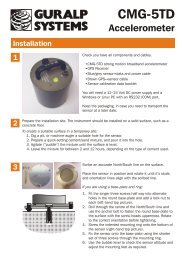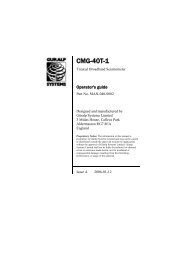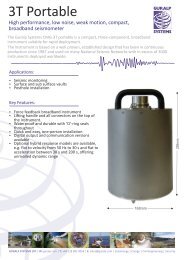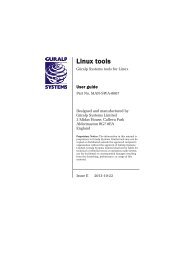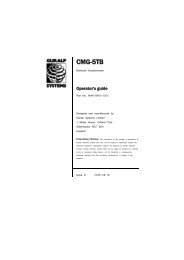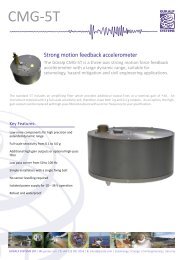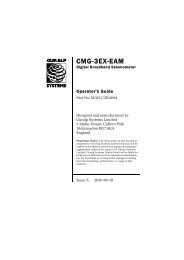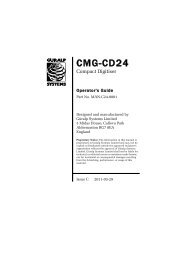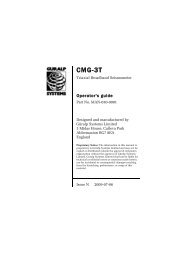Create successful ePaper yourself
Turn your PDF publications into a flip-book with our unique Google optimized e-Paper software.
CMG-6TC<br />
Operators' Guide<br />
Document No. <strong>MAN</strong>-060-<strong>0005</strong><br />
Designed and manufactured by<br />
<strong>Güralp</strong> <strong>Systems</strong> <strong>Limited</strong><br />
3 Midas House, Calleva Park<br />
Aldermaston RG7 8EA<br />
England<br />
Proprietary Notice: The information in this document is<br />
proprietary to Guralp <strong>Systems</strong> <strong>Limited</strong> and may be copied or<br />
distributed for educational and academic purposes but may<br />
not be used commercially without permission.<br />
Whilst every effort is made to ensure the accuracy,<br />
completeness or usefulness of the information in the<br />
document, Guralp <strong>Systems</strong> <strong>Limited</strong> nor any employee assumes<br />
responsibility or is liable for for any incidental or<br />
consequential damages resulting from the use of this<br />
document.<br />
Issue A September 2011
CMG-6TC<br />
Contents<br />
Table of Contents<br />
1 Preliminary Notes.............................................................................................................1<br />
1.1 Proprietary Notice......................................................................................................1<br />
1.2 Warnings, Cautions and Notes..................................................................................1<br />
1.3 Manuals and Software...............................................................................................1<br />
1.4 Conventions................................................................................................................1<br />
2 Equipment Overview........................................................................................................2<br />
2.1 Introduction................................................................................................................2<br />
2.2 Features...................................................................................................................... 2<br />
2.3 Build options.............................................................................................................. 3<br />
2.4 Ports and Connections...............................................................................................3<br />
2.4.1 Ports..................................................................................................................... 3<br />
2.4.2 Breakout box.......................................................................................................3<br />
3 Setting up the CMG-6TC...................................................................................................4<br />
3.1 Introduction................................................................................................................4<br />
3.2 Handling notes...........................................................................................................4<br />
3.3 Deployment................................................................................................................ 4<br />
4 Configuring the response mode........................................................................................6<br />
4.1 Setting the response mode using the serial console.................................................6<br />
4.2 Setting the response mode using the connector pins...............................................6<br />
5 The 6TC control menu......................................................................................................8<br />
5.1 Sensor centring...........................................................................................................9<br />
5.2 Response mode...........................................................................................................9<br />
5.3 Other controls...........................................................................................................10<br />
6 Appendices...................................................................................................................... 11<br />
6.1 Appendix A - 26 pin Connector pin-outs................................................................11<br />
6.2 Appendix B - Specifications....................................................................................12<br />
6.3 Appendix C - Revision history.................................................................................13<br />
<strong>MAN</strong>-060-<strong>0005</strong> Issue A - September 2011
CMG-6TC<br />
Preliminary Notes<br />
1 Preliminary Notes<br />
1.1 Proprietary Notice<br />
The information in this document is proprietary to Guralp <strong>Systems</strong> <strong>Limited</strong><br />
and may be copied or distributed for educational and academic purposes but<br />
may not be used commercially without permission.<br />
Whilst every effort is made to ensure the accuracy, completeness or<br />
usefulness of the information in the document, neither Guralp <strong>Systems</strong><br />
<strong>Limited</strong> nor any employee assumes responsibility or is liable for for any<br />
incidental or consequential damages resulting from the use of this document.<br />
1.2 Warnings, Cautions and Notes<br />
Warnings, cautions and notes are displayed and defined as follows:<br />
Caution: A triangle or cautionary symbol indicates a chance of<br />
damage to or failure of the equipment if the caution is not heeded.<br />
Note: A circle indicates indicates a procedural or advisory note.<br />
1.3 Manuals and Software<br />
All manuals and software referred to in this document are available from the<br />
<strong>Güralp</strong> <strong>Systems</strong> website: www.guralp.com unless otherwise stated.<br />
1.4 Conventions<br />
Throughout this manual, examples are given of command-line interactions.<br />
In these examples, a fixed-width typeface will be used:<br />
Example of the fixed-width typeface used.<br />
Commands that you are required to type will be shown in bold:<br />
Example of the fixed-width, bold typeface.<br />
Where data that you type may vary depending on your individual<br />
configuration, such as parameters to commands, these data are additionally<br />
shown in italics:<br />
Example of the fixed-width, bold, italic typeface.<br />
Putting these together into a single example:<br />
System prompt: user input with variable parameters<br />
<strong>MAN</strong>-060-<strong>0005</strong> 1 Issue A - September 2011
CMG-6TC<br />
Equipment Overview<br />
2 Equipment Overview<br />
2.1 Introduction<br />
The CMG-6TC is an ultra-lightweight seismometer consisting of three sensors<br />
in a sealed case, which can measure simultaneously the North/South,<br />
East/West and vertical components of ground motion over a wide frequency<br />
range. This frequency response is<br />
made possible by advanced forcebalance<br />
feedback electronics. It<br />
is ideally suited for rapid,<br />
temporary installations in<br />
locations with medium noise.<br />
The robust sensor elements<br />
are designed so that no<br />
mechanical clamping is<br />
required. Because of this, the<br />
6TC is ready to record ground<br />
movements as soon as you<br />
provide it with power and the<br />
processor has booted-up. The<br />
instrument will operate with up<br />
to 20° of tilt (if buried; up to 10° if<br />
free-standing) but better results<br />
will be obtained if the base is<br />
within 3° of the horizontal and<br />
installed on a hard surface, well<br />
coupled to the bedrock.<br />
Each instrument is delivered with a<br />
detailed calibration sheet showing its<br />
serial number, measured frequency response<br />
(in both the long period and short period sections of the seismic spectrum),<br />
sensor output calibration figures and the instrument's transfer function,<br />
specified in “poles and zeroes” notation.<br />
2.2 Features<br />
• Compact size: 89mm x 160mm<br />
• True broadband, three-component, force-feedback instrument<br />
• Direct velocity outputs<br />
• Lightweight (1.2kg) and waterproof to 1 metre submersion<br />
• No mass clamping required – plug in and go<br />
<strong>MAN</strong>-060-<strong>0005</strong> 2 Issue A - September 2011
CMG-6TC<br />
Equipment Overview<br />
• High sensitivity and dynamic range (>135 dB)<br />
• Orthogonal instrument with high cross-axis rejection (>65 dB)<br />
• The sensor response is completely flat across the entire passband. Its<br />
high-gain feedback loop eliminates mechanical non-linearity (the overall<br />
measured linearity exceeds 95 dB) and minimizes resonances in the<br />
spring system.<br />
• Low-frequency vibration modes are carefully avoided in the design. The<br />
lowest spurious vibration mode of the 6TC is a barely measurable<br />
resonance at 440Hz.<br />
Refer to Appendix B on page 12 for full specifications.<br />
2.3 Build options<br />
The CMG-6TC is supplied in two standard build versions:<br />
Selectable 1, 10, 30 and 60 second low frequency corner, flat to 100Hz<br />
Selectable 1, 30, 60, 120 second low frequency corner, flat to 100Hz<br />
A 50Hz option is available on request.<br />
The responses for each build versions are user configurable. See section 4 on<br />
page 6 for details on how to configure the responses.<br />
2.4 Ports and Connections<br />
2.4.1 Ports<br />
Note: Refer to Appendix A on page 11 for information on connector<br />
pin-outs.<br />
A single 26-pin connector provides power to the instrument and supplies<br />
analogue data from the sensors. A TTL-level serial interface is also exposed<br />
on the same connector.<br />
The supplied cable has a 26-pin instrument connector at one end and either a<br />
26 way connector or free pigtails at the other (depending on customer<br />
requirements).<br />
2.4.2 Breakout box<br />
An optional breakout box is available and comes with all necessary cables to<br />
connect the instrument to a power supply, digitiser and hand-held control<br />
unit, as required.<br />
<strong>MAN</strong>-060-<strong>0005</strong> 3 Issue A - September 2011
CMG-6TC<br />
Setting up the CMG-6TC<br />
3 Setting up the CMG-6TC<br />
3.1 Introduction<br />
The CMG-6TC is delivered in a single transportation case. The packaging is<br />
specifically designed and should be reused whenever you need to transport<br />
the instrument.<br />
Note any damage to the packaging when you receive the equipment and then<br />
unpack, ensuring the following are present:<br />
• The seismometer;<br />
• The thermal insulation jacket;<br />
• The calibration and installation sheet.<br />
• The connection cable (which contains a DC-DC power converter); and<br />
• The attachable North/South alignment tool, if ordered<br />
The instrument is factory set to the customer-specified response mode. To<br />
change the response mode before deployment, carry out the procedure<br />
detailed in section 4 on page 6.<br />
3.2 Handling notes<br />
• Avoid bumping or jolting the instrument when handling or unpacking.<br />
• Do not kink or walk on the cables (especially on rough surfaces such as<br />
gravel) or allow any cable to bear the weight of the instrument.<br />
• Do not connect the instrument to power sources, except where<br />
instructed.<br />
• Do not ground any of the signal lines from the sensors.<br />
3.3 Deployment<br />
Note: Refer to Appendix A on page 11 for information on connector<br />
pin-outs.<br />
1. Stand the instrument on bedrock where possible or, at least, deep in<br />
well-compacted subsoil. Remove all loose material from the mounting<br />
surface as this will ensure good contact between the instrument and the<br />
surface.<br />
2. Align the instrument along the North/South axis using the indicators<br />
engraved on the top cover or the optional alignment tool (an extended<br />
pointer which locates into the two recesses in the top cover).<br />
<strong>MAN</strong>-060-<strong>0005</strong> 4 Issue A - September 2011
CMG-6TC<br />
Setting up the CMG-6TC<br />
3. For best results, level the instrument using the adjustable feet and<br />
bubble level. The instrument can stand unsupported and function on a<br />
surface tilted by up to 10°. If buried, the instrument will still function<br />
with a tilt of up to 20° but the quality of the output signals will be<br />
compromised.<br />
4. Lock the adjustable feet in position using the knurled brass locking nuts.<br />
The feet are locked when the knurled nuts are tight against the base of<br />
the instrument.<br />
5. Install the thermal jacket to protect against temperature fluctuations.<br />
6. Referring to the instrument pin-outs in Appendix A on page 11:<br />
a. Connect the instrument to suitable digitiser, such as a CMG-CD24<br />
or CMG-DM24.<br />
b. Connect the instrument to a 9-36 VDC power supply.<br />
7. Allow a few seconds for the instrument's processor to boot<br />
8. The instrument is now operational and transmitting data.<br />
9. Allow 4 minutes for the instrument to auto-centre.<br />
Note 1: Guralp systems can supply breakout boxes, cables,<br />
digitisers and software for data conversion and analysis.<br />
Note 2: If you are using a Guralp <strong>Systems</strong> digitiser, refer to the<br />
digitiser manual for details on how to set up and receive data.<br />
10. If installed in a hole, the instrument can be sealed in a plastic bag (to<br />
keep it clean) prior to infilling.<br />
11. After installation, the instrument and mounting surface will slowly<br />
adjust to the local temperature, and settle in their positions. This<br />
typically takes around four hours from the time installation is<br />
completed.<br />
<strong>MAN</strong>-060-<strong>0005</strong> 5 Issue A - September 2011
CMG-6TC<br />
Configuring the response mode<br />
4 Configuring the response mode<br />
The CMG-6TC is available in two versions. Each version has a set of four<br />
different frequency response modes, from which the operator can choose.<br />
The four response modes are referred to as SP (short period), SMP (shortmedium<br />
period), LMP (long-medium period) and LP (long period).<br />
Response<br />
Mode<br />
Build Version A pass-band Build Version B pass-band<br />
SP 1 second to 100 Hz * 1 second to 100 Hz *<br />
SMP 10 seconds to 100 Hz * 30 seconds to 100 Hz *<br />
LMP 30 seconds to 100 Hz * 60 seconds to 100 Hz *<br />
LP 60 seconds to 100 Hz * 120 seconds to 100 Hz *<br />
* Versions with 50Hz low-pass corners are also available.<br />
The response mode can be changed at any time using either of the following<br />
methods:<br />
1. Using the serial console menu (see section 5.2 on page 9).<br />
2. By connecting specific pins on the connector to digital ground (see<br />
section 4.2 on page 6).<br />
In order to use the first method (serial console menu), connector pins S and T<br />
should be left open circuit (not connected).<br />
In order to use the second method (connector pins), the serial console menu<br />
should first be used to set the response mode to “LP” (option 0).<br />
4.1 Setting the response mode using the serial console<br />
To configure the 6TC response mode using the serial console menu, follow<br />
the instructions given in section 5 on page 8. Note that pins S and T on the<br />
connector should be left open circuit when relying on the menu to set the<br />
response mode.<br />
4.2 Setting the response mode using the connector pins<br />
Note: Refer to Appendix A on page 11 for information on connector<br />
pin-outs.<br />
In order to set the response mode using the connector pins, the serial menu<br />
should first be used to set the response mode to “LP” (option 0). If any other<br />
mode is selected via the serial menu, only that mode and “SP” mode can be<br />
enabled using the connector pins.<br />
<strong>MAN</strong>-060-<strong>0005</strong> 6 Issue A - September 2011
CMG-6TC<br />
Configuring the response mode<br />
1. Identify pins S, T and Y on the instrument connector.<br />
2. Connect pin S and/or pin T to pin Y (digital ground) as required,<br />
according to the following table:<br />
Response mode<br />
Pin S<br />
Pin configuration<br />
Pin T<br />
SP Connect to pin Y Connect to pin Y<br />
SMP Leave unconnected Connect to pin Y<br />
LMP Connect to pin Y Leave unconnected<br />
LP Leave unconnected Leave unconnected<br />
Note: If a mode other than “LP” has been selected using the serial<br />
console menu, it is still possible to select “SP” mode using the<br />
connector pins by connecting both pin S and pin T to pin Y.<br />
<strong>MAN</strong>-060-<strong>0005</strong> 7 Issue A - September 2011
CMG-6TC<br />
The 6TC control menu<br />
5 The 6TC control menu<br />
Note: Refer to Appendix A on page 11 for information on connector<br />
pin-outs.<br />
The CMG-6TC has a serial console, which can be accessed via pins<br />
Y (ground), Z (console output) and a ( console input) of the connector. This<br />
is a TTL-level interface (rather than RS232) so a suitable adaptor is required<br />
before it can be interfaced directly to, say, a PC or laptop.<br />
1. Using a suitable TTL-to-USB or TTL-to-Serial adaptor, connect pins Y, Z<br />
and a on the instrument connector to a PC.<br />
2. Connect the instrument to a power supply as follows:<br />
• If using the optional Guralp supplied cable, a DC supply of between<br />
9V and 36V is required.<br />
• If you are connecting directly to the instrument, a ±5V DC supply<br />
is required.<br />
3. Open a connection from the PC to the instrument using terminal<br />
emulator software such as: minicom or picocom (Linux); or<br />
Hyperterminal or PuTTY (Windows). Configure the connection to<br />
38,400 baud, 8 data bits, no stop bits, 1 parity bit (“8-N-1”) and no<br />
hardware or software flow-control.<br />
4. Once a connection has been established, disconnect and re-connect the<br />
instrument's power supply to re-boot it.<br />
5. The boot sequence should look something like this:<br />
Guralp <strong>Systems</strong> Ltd 6TC SoH v1.0 mgs 29/06/11 (Build 07f)<br />
Built 29 Jun 2011, 15:44:16<br />
Red Amber<br />
W6461 T6E90 Green<br />
System Test Passed<br />
ESC for manual control 5 4 3 2 1 0<br />
<strong>MAN</strong>-060-<strong>0005</strong> 8 Issue A - September 2011
CMG-6TC<br />
The 6TC control menu<br />
6. To access the control menu press the key before the figures<br />
indicated in red count down to zero.<br />
The control menu looks like this:<br />
SENSORS : A_ll, V_ertical, N_orth, E_ast – centre<br />
MODE : S_hortperiod, B_roadband, R_esponse<br />
M_ass positions : I_inclination : O_ffset null ADXL : e_X_it<br />
:- KEY ?<br />
To exit the control menu and continue with a normal system start, press<br />
the key. For explanation of all other keys see the following sections.<br />
After any control menu operation is completed, the control menu will redisplay.<br />
5.1 Sensor centring<br />
To centre the sensors, press the , , or keys as required.<br />
The sensors will auto-centre during start up: manual centring is only required<br />
for diagnostic or testing purposes.<br />
5.2 Response mode<br />
Option<br />
mode:<br />
displays the following menu, used for selecting the response<br />
Select System Bandwidth 0=LP, 1=LMP, 2=SMP, 3=SP<br />
The response mode options are given in the following table:<br />
Required Response<br />
(in seconds)<br />
Build Version<br />
A<br />
Build version<br />
B<br />
Menu Key<br />
Designation<br />
1 1 SP<br />
10 30 SMP<br />
30 60 LMP<br />
60 120 LP<br />
In addition to configuring the mode for normal operations, it is also possible<br />
to set the instrument temporarily into short-period mode, in order to assess<br />
the effects of adjustments to the instrument's inclination during installation.<br />
<strong>MAN</strong>-060-<strong>0005</strong> 9 Issue A - September 2011
CMG-6TC<br />
The 6TC control menu<br />
Option (Short-period mode) over-rides any selected response mode<br />
(whether hardware or software configured) and temporarily changes the<br />
response mode to one second (SP) for as long as the control menu is active –<br />
i.e. until the system is allowed to boot normally or “broadband mode” is<br />
selected (see option , below).<br />
Option (Broadband mode) cancels the temporary short-period mode and<br />
restores the configured response mode. Note that, when the instrument boots,<br />
it will always revert to the normally configured response mode.<br />
5.3 Other controls<br />
Option<br />
Option<br />
displays the current mass positions.<br />
returns the internally measured inclination.<br />
Option resets the offset-null. This can be used when the internallymeasured<br />
inclination appears to be different to the actual inclination.<br />
Resetting the offset should result in an internally measured inclination<br />
reading of 0°, regardless of the actual, physical inclination.<br />
Option<br />
process.<br />
exits the control menu and continues with the normal boot<br />
<strong>MAN</strong>-060-<strong>0005</strong> 10 Issue A - September 2011
CMG-6TC<br />
Appendices<br />
6 Appendices<br />
6.1 Appendix A - 26 pin Connector pin-outs<br />
This is a standard 26-pin “mil-spec” plug,<br />
conforming to MIL-DTL-26482 (formerly<br />
MIL-C-26482). A typical part-number is<br />
02E-16-26P although the initial “02E” varies with<br />
manufacturer.<br />
Suitable mating connectors have part-numbers like<br />
***-16-26S and are available from Amphenol, ITT<br />
Cannon and other manufacturers.<br />
Pin Function Pin Function<br />
A Velocity +ve, vertical channel P Calibration signal (all channels)<br />
B Velocity –ve, vertical channel R Calibration enable (all channels)<br />
C Velocity +ve, N/S channel S Response mode selection<br />
D Velocity –ve, N/S channel T Response mode selection<br />
E Velocity +ve, E/W channel U Centre<br />
F Velocity –ve, E/W channel V not connected<br />
G Mass position, vertical channel W not connected<br />
H not connected X not connected<br />
J Mass position, N/S channel Y Data ground<br />
K Factory use only Z Console Output (TTL-level)<br />
L Mass position, E/W channel a Console Input (TTL-level)<br />
M Power -5 Volts b Power ground<br />
N Signal ground c Power +5 Volts<br />
Wiring details for the compatible socket,<br />
***-16-26S, as seen from the cable end (i.e. when<br />
assembling).<br />
<strong>MAN</strong>-060-<strong>0005</strong> 11 Issue A - September 2011
CMG-6TC<br />
Appendices<br />
6.2 Appendix B - Specifications<br />
Parameter<br />
Velocity output bandwidth<br />
Velocity output sensitivity<br />
Peak output<br />
Linearity<br />
Cross-axis rejection<br />
Specification<br />
1, 10, 30, 60 seconds at 100Hz<br />
or<br />
1, 30, 60, 120 seconds at 100Hz<br />
2 x 1,200 V/ms -1 (standard),<br />
2 x 750 V/ms -1 (optional)<br />
2 x 2,000 V/ms -1 (optional)<br />
2 x 4,000 V/ms -1 (optional)<br />
±5V (20V peak-to-peak) – standard output<br />
±10V (40V peak-to-peak) – high-power<br />
output<br />
> 95 dB<br />
> 65 dB<br />
Electronics self-noise -172 dB (relative to 1 m 2 s -4 Hz -1 )<br />
Operating temperature<br />
-20 to +60°C<br />
Temperature sensitivity < 0.6 V per 10 °C<br />
Horizontal tilt tolerance<br />
Construction<br />
Case diameter<br />
Case height (with handle)<br />
Weight<br />
±20° from horizontal<br />
Hard anodised aluminium case, gold plated<br />
contacts, O-ring seals throughout, exceeding<br />
IP67<br />
89mm<br />
160mm<br />
1.20 kg<br />
Power supply 9 - 36 VDC / ±5V<br />
Power consumption<br />
Calibration controls<br />
Optional accessories<br />
140mW (without cable and standard output)<br />
200mW (with cable)<br />
common signal and enable lines exposed on<br />
sensor connector<br />
Break-out box<br />
Combined power/signal cable<br />
Right angled connector<br />
<strong>MAN</strong>-060-<strong>0005</strong> 12 Issue A - September 2011
CMG-6TC<br />
Appendices<br />
6.3 Appendix C - Revision history<br />
2010-04-28 A New document<br />
<strong>MAN</strong>-060-<strong>0005</strong> 13 Issue A - September 2011




